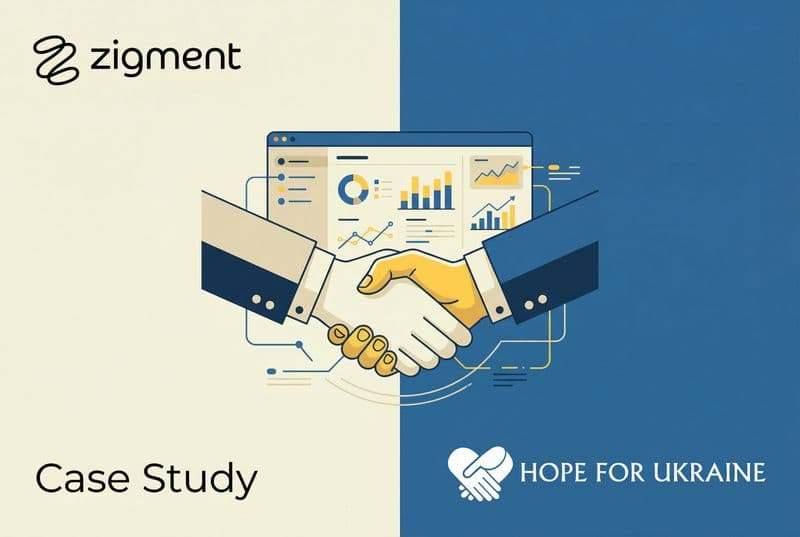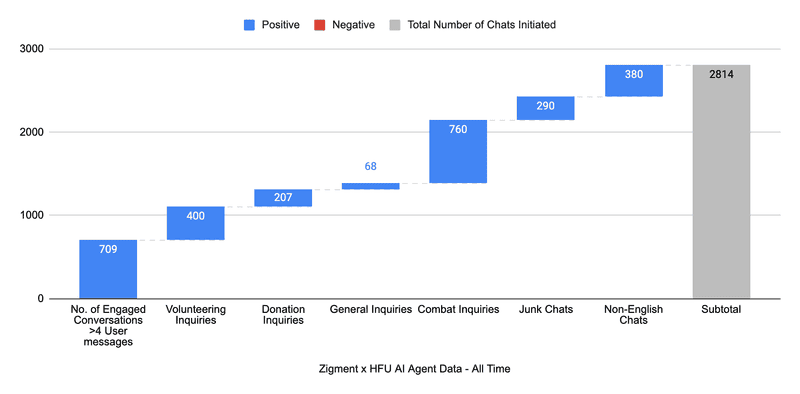Donor Journey Orchestration Case Study: Hope For Ukraine X Zigment

Ten hours.
That is how much time Hope For Ukraine’s team now gets back every single week because one conversational AI agent quietly handles the questions that used to clog their inbox.
This is not a giant global foundation with an army of staff. It is a humanitarian nonprofit working in the middle of an ongoing war, juggling donors, volunteers, and people searching for help across time zones and languages.

Every unanswered message feels like a missed chance to help someone faster.
When Hope For Ukraine added a Zigment conversational AI agent to their website, a few things happened at once:
- Routine questions moved off the team’s plate.
- Conversations scaled to hundreds per month without hiring.
- Supporters suddenly started getting help in eighteen languages.
In this article, we will walk through the most surprising lessons from that journey and what they mean if you are leading a nonprofit and wondering whether conversational AI is worth the effort.
1. AI Did Not Replace Staff; It Gave Them Ten Hours Back Every Week
The fear is familiar.
“If we bring in AI, will it replace someone on the team”
Hope For Ukraine had the same concern. So they started small. They let the Zigment conversational AI agent handle the questions that were clearly repeatable:
- Basic information about the organization and its mission
- Donation logistics and receipts
- Volunteer sign-up questions
- Simple program details that already existed on the site
It turned out that this narrow slice was not small at all. Once the agent went live, it absorbed enough of these interactions to give the team around ten hours back every week. That is ten hours they could now invest in:
- Deep conversations with major donors
- Sensitive cases that need human judgment
- Coordination with partners on the ground
The lesson is practical. The first win from conversational AI is not magic. It is reclaiming time from tasks your team already does, but should not need to do manually every single day.
2. One AI Agent Now Handles Over 500 Conversations Every Month
On paper, many nonprofits think their volume is too low to bother with conversational AI. In reality, conversations add up fast when you zoom out from a single day to an entire month.
For Hope For Ukraine, the Zigment AI agent now:
- Handles more than five hundred conversations per month
- Engages in around seventeen conversations per day on average
- Responds instantly, regardless of time of day or day of the week
What are people asking
- Prospective donors check how their contributions are used.
- Volunteers ask about safety and logistics before committing.
- Community members search for information on aid, programs, and contacts.
The team did not have this many meaningful touch points before. Many visitors would have left the site with half answered questions or none at all.

The interesting shift here is that conversational AI turned the website into a living front door for dialogue, not just a static brochure.
3. Supporters Spoke In 18 Languages, And AI Met Them There
Humanitarian work is global by nature. Support does not arrive in a single language, and trust is hard to build if someone must struggle through a foreign interface to get answers.
Hope For Ukraine’s conversational AI agent has already:
- Held conversations in more than eighteen languages
- Seen about fifteen percent of all conversations happen in non-English languages
- Helped donors, volunteers, and community members without them needing to switch languages
Picture a donor in Poland, a volunteer in Germany, and a relative looking for information while on the move. All three can open the same site and simply start talking in the language that feels natural. The agent responds accordingly.
For a small team, this is impossible to replicate with human staff alone. Multilingual support is no longer a stretch goal. It becomes part of the baseline experience.
4. Starting With One Website Surface Opened The Door To A Bigger AI Strategy
Hope For Ukraine did not try to “do AI everywhere” on day one. They chose one surface that clearly mattered: the website.
They picked a focused starting point:
- Channel: website conversations only
- Scope: supporter questions and basic information
- Success metric: hours saved and faster responses
From there, the data started to speak:
- They could see which questions appeared again and again.
- They spotted gaps in their content and updated key pages.
- They identified follow-up journeys for donors who asked about recurring gifts or specific programs.
Zigment’s platform is built as an agentic orchestration layer, which means the same intelligence that handles website conversations can extend to other channels such as email, SMS, and social once the team is ready. But the first move was intentionally modest.
5. Real-Time Conversation Turned The Website Into A Donor Engagement Channel
Most nonprofit websites are still designed as digital brochures. They inform, but they rarely converse.
By adding a conversational AI agent, Hope For Ukraine turned their site into an active engagement channel. The agent now:
- Welcomes visitors and offers help within seconds
- Keeps donors on the site by resolving doubts in real time
- Guides people toward the right next step, whether that is learning more, signing up, or giving
The important part is not only response speed. It is context. Because the agent sits on Zigment’s data layer, it can understand where someone is on the site and tailor replies accordingly. A visitor on the donation page receives different prompts than someone reading an impact story.
This lifts conversion in a natural way. Fewer people bounce with half-formed questions. More leave feeling informed and confident.
6. Ethical Guardrails And Human Oversight Were Built In From Day One
Working in a conflict setting raises a crucial question. Can we trust AI with sensitive conversations
Hope For Ukraine and Zigment treated this as a design requirement, not an afterthought. Together they:
- Trained the agent primarily on HFU’s own content and approved knowledge
- Set clear boundaries on what the agent can and cannot answer
- Kept humans firmly in the loop through regular reviews and improvements
This blend matters. The agent handles the volume and the repetition. The team keeps control over tone, accuracy, and sensitive edge cases. For a humanitarian context, that balance is essential.
7. AI Made The Invisible Work Visible And Changed How HFU Plans
Before conversational AI, supporter questions arrived as scattered emails and messages. Patterns were hard to see. Now every interaction becomes a data point in what we can think of as a Conversation Graph.
The team can notice trends such as:
- Rising questions about winter shelter before the season begins
- Frequent concerns about donation security signal a need for clearer messaging
- Spike in interest around specific programs or regions that might deserve a dedicated campaign
This is where conversational AI grows from “support channel” into “strategy partner”. The same system that answers questions also shows leadership what people worry about, what they do not understand, and what they care about most.
What Other Nonprofits Can Borrow From The Hope For Ukraine Playbook
You do not need a dedicated AI team to start. The core steps are straightforward:
- Pick one frontline friction point, like slow responses on your website.
- Define one clear success metric, such as hours saved or average response time.
- Start in one channel, then expand once you see real value.
- Make multilingual support part of your requirements, not a future upgrade.
- Treat ethics and human oversight as features of the implementation, not fine print.
With a platform like Zigment, the conversational AI agent sits on a shared data and orchestration layer, so every new channel is an extension, not a separate project.
From Overwhelmed Inbox To Agentic Partner
Hope For Ukraine’s experience is simple and powerful. One conversational AI agent now:
- Gives their team about ten hours back every week
- Handles more than five hundred conversations every month
- Meets supporters in eighteen languages without adding staff
Most importantly, it does this while keeping humans focused where they matter most: on the complex, the delicate, and the deeply human work that no system can or should replace.
The real question is not whether AI will transform the nonprofit sector someday. It is what would change for your own mission if you had an always available, multilingual colleague quietly handling unstructured questions all day, every day.